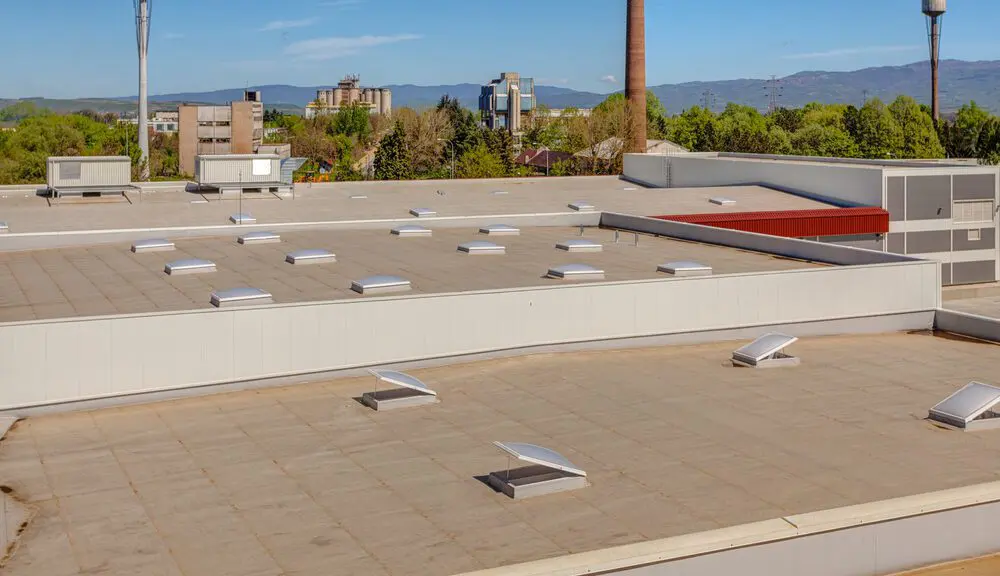Commercial properties come in various shapes and sizes, each with its unique architectural needs. When it comes to roofing solutions for these buildings, commercial flat roofs have gained immense popularity. They offer versatility, energy efficiency, and easy maintenance. In this article, we will explore different commercial flat roof types, helping you make an informed decision for your commercial property.

Understanding Commercial Flat Roofs
Commercial flat roofs are exactly what they sound like – roofs with a minimal slope or pitch. They are commonly found on a wide range of structures, including office buildings, warehouses, retail stores, and more. Here, we’ll delve into some popular types of commercial flat roofs:
1. Built-Up Roofing (BUR)
Layers of Durability
Built-Up Roofing, also known as BUR, is one of the oldest and most trusted commercial flat roofing systems. It consists of multiple layers of bitumen, alternating with layers of reinforcing fabric or ply sheets. The top layer often includes gravel or a reflective coating. BUR roofing is known for its durability and ability to withstand heavy foot traffic.
2. Modified Bitumen Roofing
Enhanced Flexibility
Modified Bitumen roofing is a variation of BUR that incorporates modified asphalt to improve its flexibility and durability. It is available in rolls, making it easier to install. Modified Bitumen roofs are resistant to damage from UV rays and extreme weather conditions, making them an excellent choice for commercial properties.
3. TPO (Thermoplastic Olefin) Roofing
Energy-Efficient and Environmentally Friendly
TPO roofing is a popular choice for those looking for energy efficiency. It’s a single-ply roofing membrane made of a thermoplastic compound. TPO roofs are highly reflective, reducing heat absorption and keeping your building cooler. They are also environmentally friendly and easy to install.
4. EPDM (Ethylene Propylene Diene Monomer) Roofing
Proven Durability
EPDM roofing is another single-ply membrane roofing system known for its longevity. It is made from a synthetic rubber compound and is resistant to UV rays and weathering. EPDM roofs are easy to repair, making maintenance a breeze.
5. PVC (Polyvinyl Chloride) Roofing
Chemical Resistance and Durability
PVC roofing is a single-ply membrane system known for its chemical resistance and durability. It is highly reflective and offers excellent protection against water, chemicals, and pollutants. PVC roofs are often chosen for their low-maintenance requirements and energy efficiency.
Selecting the Right Commercial Flat Roof
Choosing the appropriate commercial flat roof for your property involves considering several factors:
1. Climate and Weather Conditions
Your location’s climate plays a significant role in determining the best roofing material. Some materials, like TPO and PVC, are better suited for hot climates, while others, such as EPDM, excel in cold regions.
2. Budget and Longevity
Consider your budget and the expected lifespan of the roofing material. While some options may be cost-effective initially, they may require more frequent repairs or replacements.
3. Energy Efficiency
If energy efficiency is a priority, TPO and PVC roofing are excellent choices due to their reflective properties.
4. Maintenance
Think about the maintenance requirements of the chosen roofing material. EPDM and TPO stand out for their low maintenance requirements, rendering them ideal for properties with constrained maintenance budgets.
Conclusion
Commercial flat roof types offer a versatile and cost-effective solution for various commercial properties. Each type of flat roofing system comes with its unique set of advantages and considerations. By understanding the differences between these roofing options and evaluating your property’s specific needs, you can make an informed decision that ensures the long-term protection and efficiency of your commercial building.



Leave a Reply